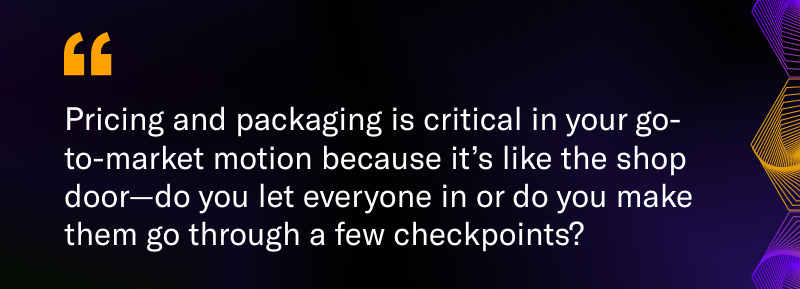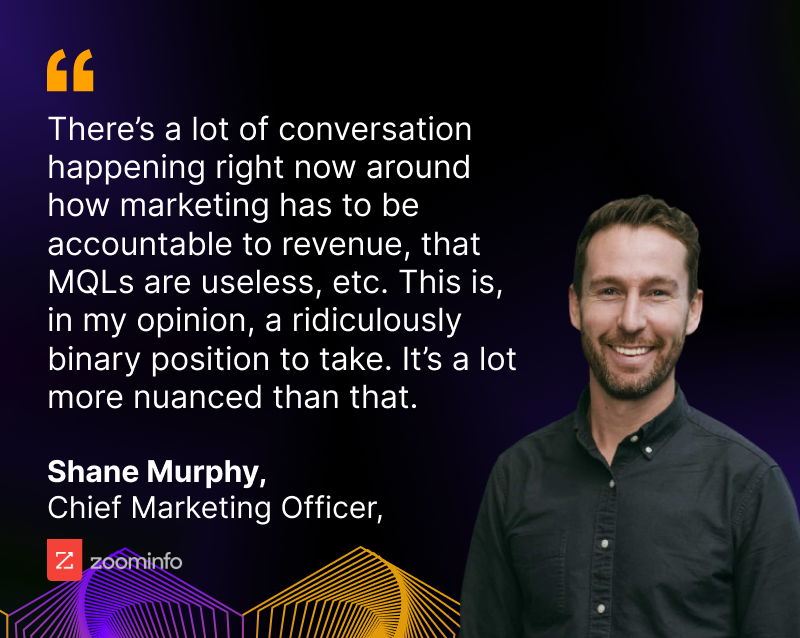Go-To-Market Strategies and Intent Data: Meet Shane Murphy-Reuter from ZoomInfo

Maximize Your Marketing ROI
Join 10,000 other marketers already getting the best tips on running engaging events that boost pipeline and create raving fans.
In this episode of CMO Diaries, Kishore met with Shane Murphy-Reuter, Chief Marketing Officer at ZoomInfo.
ZoomInfo is a unified system of data, insights, software and integrations that creates complete visibility into how to identify, engage and convert customers within your total addressable market. As the world’s first revenue operating system, ZoomInfo is so much more than just a data provider. Their platform provides a unified system of data, insights, software, and integrations that creates complete visibility into how to identify, engage and convert within your total addressable market.
Prior to joining ZoomInfo, Shane spent time at data giants like AdRoll and Intercom. He shared his insight on how to market an enterprise product across multiple buyer personas, when to use different SaaS growth models based on your go-to-market strategy, and predictions on the future of intent data.

How do you market an enterprise product to multiple personas?
There are certain parts of your story that should hold true no matter who you are talking to. For example, Ryanair in Europe (similar to JetBlue in America) is a low cost airline, so no matter what they do—a credit card, a taxi service, etc.—it’s going to stick to their “low cost” core theme.
You need to figure out what your central story is. What are the things, no matter what product you build or what market you sell to, that are core to your identity?
“There are certain parts of your story that should hold true no matter who you are talking to.”
At ZoomInfo, our story is about how data is the bedrock of all marketing and sales and about the importance of having an interconnected suite of tools.
If we’re talking to a marketer, we say things like, “Isn’t it embarrassing when you send an email with the wrong name? You target the wrong person? You waste marketing spend? Data is the best way to solve these issues. Wouldn't it be great if your data was connected to what the sales team uses to reach out so you could work in tandem and attack accounts?”
If we’re talking to a sales team, we use this same story, just with slightly different messaging and examples.
The key to winning with multiple personas is to figure out what your specific differentiators are where you are always the best solution. And when talking to individual segments, tailor the story so that it resonates around your core message.
Having your messaging “house” is really important. You start at the top by answering, “this is why we exist in the world.” Then, move into your core differentiators and how that drives your main theme. And finally, you break those differentiators into solutions. Each level flows down and is all connected.
Do you make pricing publicly available or do you go through sales?
When I was at Intercom, I spent almost a year and a half focused on pricing and packaging. The short answer is, it depends.
It’s less about the pricing itself and more about your go-to-market strategy. Are you sales led, product led, sales assist, etc.?
Pricing and packaging is critical in your go-to-market motion because it’s like the shop door—do you let everyone in or do you make them go through a few checkpoints?
As a general rule of thumb, product-led growth is great for products that are relatively easy to onboard, are quick to add value, and have a lower lifetime value, which means you need to keep your customer acquisition cost (CAC) low. This is very much a consumer-focused model.
Sales-led growth is typically a better fit when you have a long sales cycle, the solution is hard to implement and adopt, and it takes longer to find value.

For example, at ZoomInfo, we have a product called Chorus that records sales calls and provides a ton of useful data. In order to implement that, there’s a lot of privacy to navigate, and it takes a lot of training to get teams up to speed. That product needs a sales-led approach. You can’t just go use it right out of the gate.
Alternatively, our data product is something you can start using right away. We offer a free trial, and you can login and start playing with the data right away. So, this product is naturally a better fit for the product-led growth path.
For sales-assist, start with product-led and get them using the product from a self-serve model. Then, use scoring within the product to identify product-qualified leads (PQLs) based on individual behaviors or firmographic fit for upsells and cross-sells.
Where do you see intent data in 5-10 years?
I think it depends what you’re connecting the intent to. My expectation and what has been happening is that people have been innovating on the different types of intent signals you can use. This will continue to get better. G2 has been able to get really good at this. And there are more areas for growth like using browsing behavior to generate intent. These signals of intent will continue to grow.
The companies that become better at connecting external intent data, as provided by companies like ZoomInfo, and first-party intent data are going to be the real winners.
The other side of it is, what can you tie those intent signals to? Can you tie it to an email address? Up until now, companies like Facebook have been able to tie intent across data points like who you are, your browsing behavior across devices, etc. But then Apple came in and said—you can’t do that anymore; you can’t tie those things together. So, there is a fundamental shift happening.
While the signals and intent will improve, what you can tie it to will become a challenge—especially with more legislation and regulation on the horizon.
I think we'll get much better at identifying intent signals, but tying them to things like cookies might soon become a thing of the past.
“The companies that become better at connecting external intent data, as provided by companies like ZoomInfo, and first-party intent data are going to be the real winners. “
What goals does your team have from a demand generation perspective?
The big challenge with goal setting is, how do you prevent overlap? There’s a balance, and goals should be set across sales and marketing.
There’s a lot of conversation happening right now around how marketing has to be accountable to revenue, that MQLs are useless, etc. This is, in my opinion, a ridiculously binary position to take. It’s a lot more nuanced than that.
The challenge is, if you go with something like revenue, it is obviously the thing we are ultimately trying to achieve. We absolutely need to set a goal in tandem with sales. The problem is, there are so many things outside of our control that can happen in the funnel before you get to revenue.
You end up moving further up the funnel, farther away from what you ultimately want to drive to things you can actually control (like MQLs). The reality is, all of goal setting is managers trying to balance how to keep an eye on the thing we’re ultimately trying to drive (revenue) even though we aren’t as in control of it versus places where we have complete control but it’s not something we’re trying to drive.
You have to give all teams a combination of both. You have to create models that input key performance indicators (like an MQL) where the definition of those are as best tied to revenue as possible. You can change your definition to make sure that any MQLs that are not a good fit don’t count towards the goal. But you have to start somewhere.
Overall, that balance is a challenge in goal setting. Anyone who says it’s one or the other is wrong.

As far as setting goals across the team, I think about the goals across three levels: brand, demand, convert and expand.
The brand level goals are to build awareness or change perceptions in the market. For ZoomInfo, we’re known as a data provider, but we want to change this perception and be known for a lot more than that.
At the demand level, this will depend on your go-to-market strategy like we talked about earlier (product-led growth or sales-led growth), but ultimately comes down to generating funnel or pipeline; creating intent within people so they take some action that becomes pipeline.
Finally, convert and expand is all about ensuring that, when the audiences come in, you’re doing a much better job of monetizing those audiences. This might include account based marketing (ABM) to improve pipeline conversion or upsell and cross-sell opportunities.
From there, each team has to agree on—how are we going to do this? It’s a nuanced topic.
What percent of the marketing budget would you spend on brand versus demand generation?
This depends on what market you’re in.
If you’re in a market where you’re creating a new category, you need to invest more in brand since people don’t know your category or solution exists. At that level, I would say it’s 50% / 50% split. Also remember, brand doesn't have to be media. It could be building out a great content team, launching killer events, etc. Brand doesn’t mean throwing money at a Super Bowl ad.
If you’re in an industry where everyone knows the category, there’s already two or three major players and buyers are going to compare all three, I’d put more money into lower funnel tactics to convert that demand.
“In general, if you’re spending less than 25% on your brand, you’re likely underinvesting.”
Another way to look at it is to look at your goal for market share. Then, assess your share of voice and compare the two. As a rule of thumb, if your share of voice is lower than your market share, you will lose market share (all things being equal).
When I was at Paddy Power, our market share was 12%. I was running demand generation at the time, and our market share metrics looked great, so the CFO kept increasing my budget. This was great, I was creating more and more campaigns. But what I didn’t realize was that he was re-allocating that budget from the brand team budget.
For the first six months, it was amazing. The numbers were so impressive, and we were getting so many leads. But eventually, conversion rates started dropping, the leads dried up, and our new business growth rate dropped to below 5%.
We eventually realized that our share of voice was down to about 5% versus our 12% market share, so we were starting to lose that momentum. As soon as we figured it out, we re-balanced the budget between brand and demand and were able to bump new business growth up to 32% the following year.
—
Thanks for joining us, Shane! We’ll see you soon for the next episode of CMO Diaries!

Transform Your Video Marketing with AI
Stay In Touch
Platform
Resources
© 2025 Copyright Goldcast, Inc. All rights reserved.





 Upcoming Events
Upcoming Events Event Series
Event Series On-Demand Events
On-Demand Events

